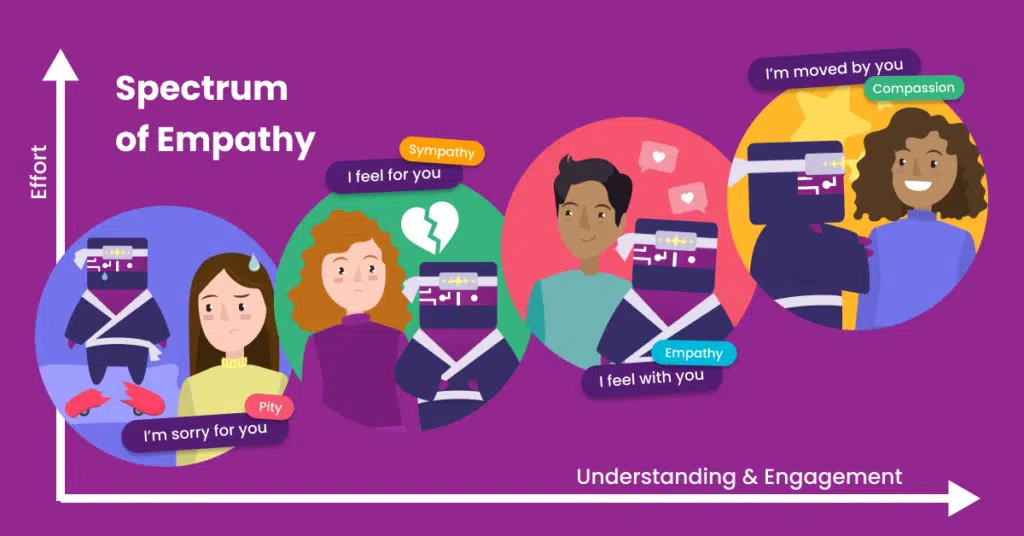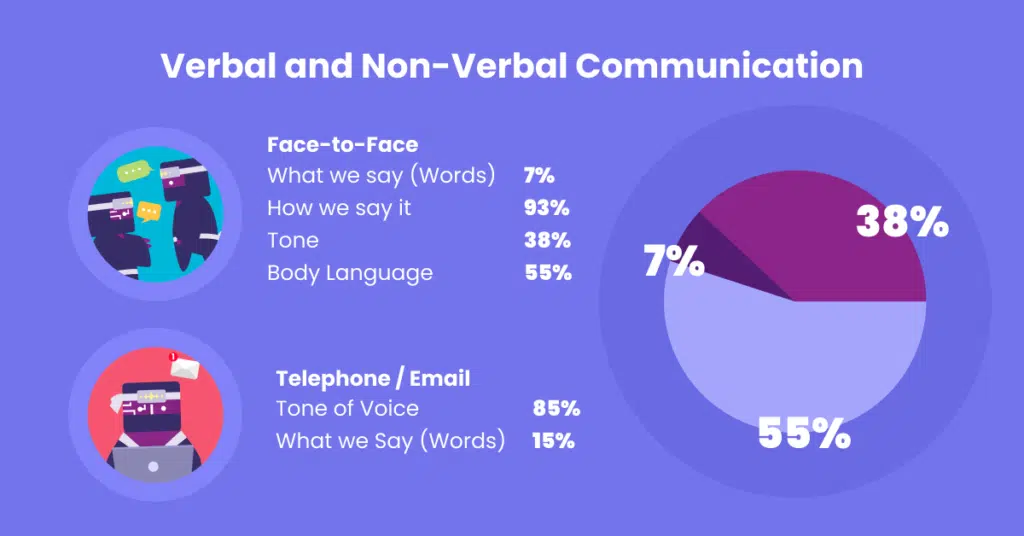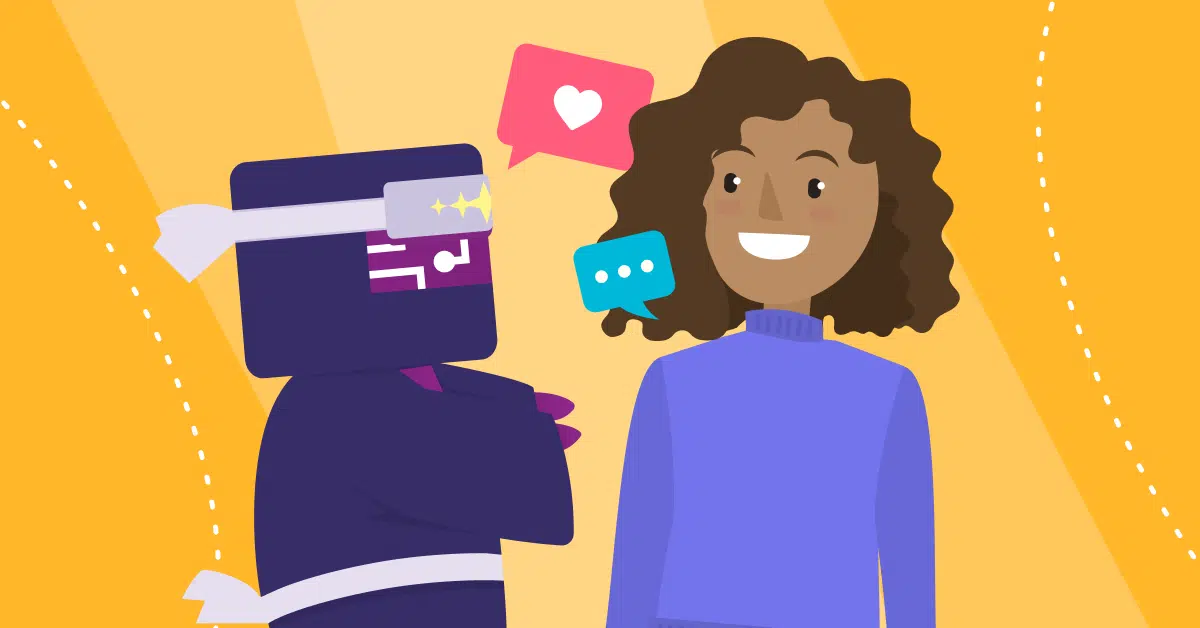Empathy in customer service matters more than you think. 61% of consumers have stopped buying from a company because a competitor provided a better customer experience. Not a better product.
In a world of increasing automation, empathy in customer service is more important than ever.
Working in customer service can be fast-paced and intense, and when a company’s reputation and success fall on your shoulders – it can be stressful and overwhelming. Especially when you constantly have to deal with the same queries and complaints. It’s easy to inadvertently get stuck in a negative mindset but, negativity usually bleeds into your communications, and your customers will quickly pick up on it.
Understanding how to control your emotional energy helps you to better realize how people perceive you. That self-awareness can help you be more directed and empathic in your responses.
But when it comes to customer service, what is empathy, really? Just how important is it for agents, teams, and the company as a whole? And the last, and quite possibly the most intriguing question — is empathy coachable?
Let’s dive in.
- What is empathy in customer service?
- Why is empathy important in customer service?
- Where did empathy in customer service go?
- Empathy training for customer service – 3 best tips
- Empathy statements for customer service
What is empathy in customer service?
Before we delve into empathy in customer service, it is important to understand the difference between empathy and sympathy. The Mirriam Webster dictionary says that sympathy is when you share the feelings of another; empathy is when you understand the feelings of another but do not necessarily share them. Basically – sympathy is in the brain, empathy is in the heart – and the one that leads to a deeper connection.
In customer service, empathy is the capacity to affirm a customer’s feelings and indicate that you can understand their frustration or pain — even if the problem was out of your control.
In other words, empathy is putting yourself in someone else’s shoes — understanding their perspective from their point of view. This isn’t always easy, but it’s worth the effort because it helps you connect with your customers and understand their needs.
After all, customer support is all about people, and if you can effectively place yourself in their situation – you can support them better. Even if you cannot resolve the issue, you can help the customer feel heard by showing empathy, recognizing, and validating their feelings.
Why is empathy important in customer service?
Customers want to be listened to. They want to feel they’re being heard and understood.
Customers are people, with feelings, emotions, and a personality. They’re not just numbers or statistics. Customers can get frustrated, annoyed, angry, and upset at your company. When this happens, they need someone to listen to them without being judgemental or hostile.
But that’s where the tricky bit comes in: it’s difficult for anyone to listen patiently when they are dealing with a frustrated customer who is venting their anger at them. It’s easy for customer service agents to become reactive and defensive when faced with an angry or frustrated customer
Empathy in customer service helps agents understand how customers feel and view the situation from the customer’s perspective. When agents can do this, they can better understand what their customers are actually saying (and not saying) and be in a better position to help solve their problems
According to Maslow’s Theory of Human Motivation, feeling understood is one of the basic human needs — it’s almost impossible to think of any business thriving without connecting to their customers. It is in that deeper, authentic connection where empathy lies.
Customer empathy helps us establish friendlier relationships with customers, identify their needs and, manage conflicts better — in turn, this helps to increase customer satisfaction and build loyalty.
When we consider that 70% of buying experiences are based on how the customer feels they are being treated, it becomes even more apparent that empathy in customer service can provide a crucial link to service excellence.
You can spend all day talking to customers who may have problems with your company. In some cases, there may not even have been a resolution – but when there is customer empathy, it not only helps your customers feel heard but by acknowledging their feeling, you provide them with a better experience. Often, it’s not about whether the problem was solved or if a refund was received. At least, it’s not entirely about those issues because the bottom line in most of your customers’ minds is emotional. How did the interaction make them feel?
Real empathy is about matching emotion, not situation.

Where did empathy in customer service go?
Often, companies introduce performance management systems that focus more on the business’s bottom line and less on the customer. Really complex systems with a focus on response times can make a significantly negative impact on quantifiable human interactions. This often happens with metrics such as Average Speed of Answer (aka ASA) and Next Issue Avoidance (aka NIA).
So, how do we find the right balance?
Empathic failure
Customer service employees are supposed to care about customers. You’re expected to listen intently, try to understand customers’ feelings and emotions, and take the appropriate action. But, constantly demonstrating empathy can be exhausting. It’s easy to become overwhelmed by all the things that drain your emotional reserves. Practicing mindfulness keeps us engaged at this moment, actively compassionate, and present.
For many companies, the absence of negative feedback is a sign of satisfaction. But, according to Kolsky, 91% of customers who are unhappy with a brand will just leave without complaining.

One of the most significant impacts of empathy fatigue is dehumanizing the person we are serving, which is easier to do with online interactions. A 2015 study discovered that we are less likely to degrade someone if empathy is more rewarding. In other words, it’s easier to empathize with a customer if we believe helping them will make us feel good.
Empathy will always be important in customer service. But as AI starts to take over more aspects of customer service, businesses need to make sure they maintain their empathy levels.
That’s one of the insights from a new report by Salesforce, which surveyed 6,700 consumers and business buyers around the world on their thoughts about customer service.
The report found that 90% of consumers think companies should always put customers first, and 91% expect companies to treat them as individuals. And although many people (57%) feel that companies fail at delivering personalized experiences, they also believe (94%) personalized experiences are important.
Overall, it seems that consumers want more human-to-human interactions when dealing with brands.
Empathy training for customer service – best tips
We often think of empathy as a personality trait if you don’t have it — too bad. Actually, it is also a skill. And all skills can be learned and, thus, they can be coached. If you take your cues from your customer data and insights, you can use situational empathy to help you develop better customer empathy. So here’s how you do it.
Focus on listening
Listening is one of the most important skills a customer service agent can have. Agents should always listen actively, meaning they should pay attention to what the customer is saying and show them that they are listening. Agents should also avoid interrupting customers when they’re speaking and instead take notes so that they can refer back to them later on if needed. They should also reflect back on what the customer has said in order to check that they understood correctly.
Recognize bias
It’s natural to make judgments based on language, color, gender, sex, religion, etc. We don’t even notice when we act out of unconscious bias, but it makes us treat some customers differently. And they notice. Bias doesn’t mean hostility towards a customer – it’s not always something we are aware of. To improve empathy in customer service, you need to recognize your biases. By noticing that you might be making wrong assumptions, you will be able to step back, assess your bias and adjust your behavior.
Manage stress
In some cases, stress and anxiety reduce empathy. In stressful situations, we become more egocentric, and it becomes difficult to see something from someone else’s perspective. During times where you know you are more stressed, try these techniques to improve your empathy responses:
- Shared Identity – If someone is very different from you, focussing on your similarities can help to invoke an empathy response.
- Mindful Breathing – Cultivate awareness and pause before responding by focusing on your breathing.
Train empathy
Whether it is good news or bad, empathy is not something everyone is born with — it is something you gain, train, and cultivate over your lifetime. Empathy is a key skill both in your professional and personal life, but in customer service, it is a game-changer.
Including empathy training in your performance coaching initiatives is a great way to help people identify, measure, and improve the way they communicate with customers. As with many other “quality features”, empathy is hard to put a number or a goal on, but with the right tools, you can set missions, give actionable advice, and help your agents become more empathetic communicators.
Empathy scenarios
Ask your customer service advisors to share their stories – it is a great way to build empathy responses to specific scenarios and gives them the chance to share personal stories. Talking about bad calls and negative reviews can also help you and your team learn from the experience to be better prepared to handle such calls in the future.
Empathy statements for customer service
It’s not always easy to convey empathy regarding a customer’s situation. Sometimes trying to show compassion can come across as pity. Other times – robotic. Empathy statements are your way of showing a customer that you understand their concerns, issues, and feelings. But, when misused, they can be perceived as watered-down, empty responses. When used correctly, however, empathy statements build trust in each customer and add a human touch to your digital service.
When it comes to providing support via email or chat, there are often voids between what you mean to say and how customers interpret your words. In fact, customers perceive digital channels as less personal than face-to-face interactions. That disconnect creates a barrier between the customer and the agent which leads to distrust and frustration for both parties involved.

What should you include in empathy statements?
- Personal pronouns – when using personal pronouns, rather than a more corporate “we”, your customer hears that you are interested in them as an individual. This makes them feel that you understand their situation and that helping them is your priority.
- Active verbs – replacing passive verbs with active verbs makes it sound like the request is more likely to be actioned. Compare: “This will be sent to our finance department” with: “I will ask our finance department to resolve this within 24 hours.”
- Authenticity – Even if you have a standardized list of empathy statements, it is crucial to still be yourself. Reading standard empathy phrases can increase anger and make the customer feel like you are not actually listening to them.
Empathy statements need to be natural and sincere. If they seem forced or insincere, they’ll have the opposite effect and make the customer angrier.
The phrase “I understand your concern” is overused and often seems like canned language. It will only frustrate customers more because it shows them that you’re not actually listening to what they’re saying. Instead of using this phrase, use the customer’s actual words in your reply.
So here’s one crucial thing to remember: It’s not all about you!
When you’re trying to show a customer that you understand their problem and the emotions that come along with it, it can be tempting to focus on yourself. You may have had a similar experience in the past and want to share that story or even suggest a solution from your personal experience. But as the old saying goes, “it’s not all about you.”
To truly empathize with someone else, you first need an understanding of where they are coming from. This means putting your own experiences and feelings aside in order to relate to theirs.
It’s also a good idea to avoid using phrases like “I feel your pain” or “I know how you feel.” These will only make customers question whether or not you can actually relate to their situation because chances are, you likely don’t know exactly how they feel. After all, everyone feels things differently!
Instead, focus on what the customer is feeling in that moment and acknowledge those feelings without inserting your own into the conversation. You can do this by using phrases like, “I can see how upsetting this must be for you” or “I can understand why this would upset you”.
Are you looking to make good communication and empathy into a coachable objective, set goals for your agents to reach as they watch their own continuous growth? See how Kaizo can make this an easy and engaging experience for you and your teams!



